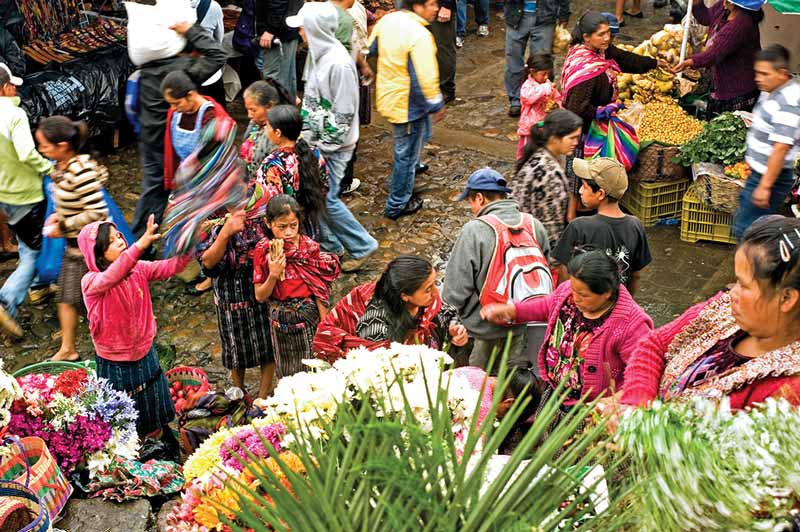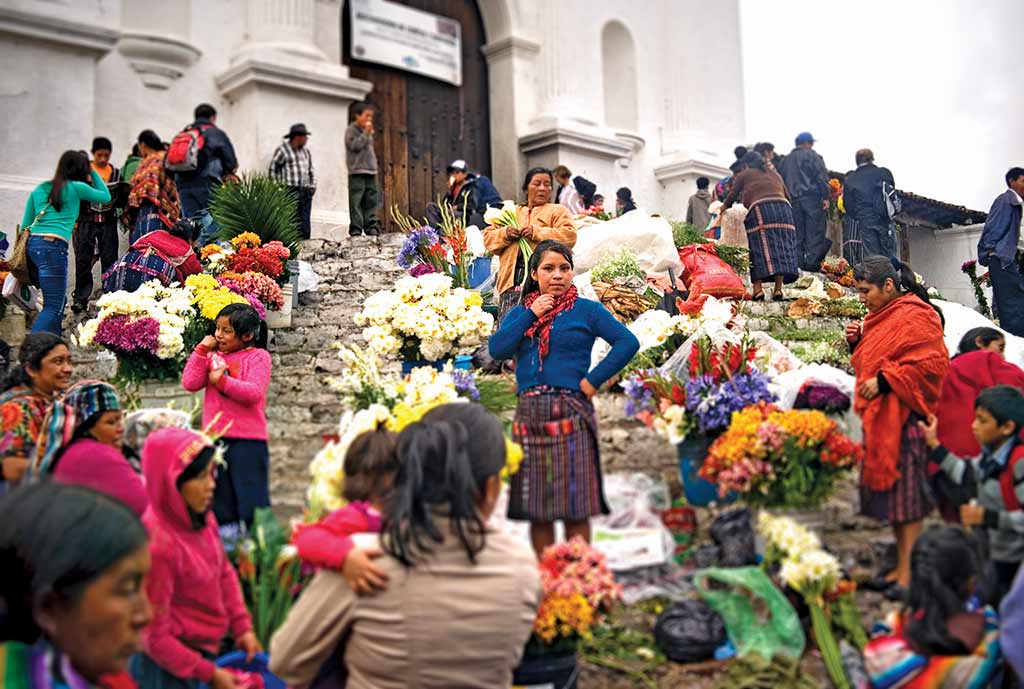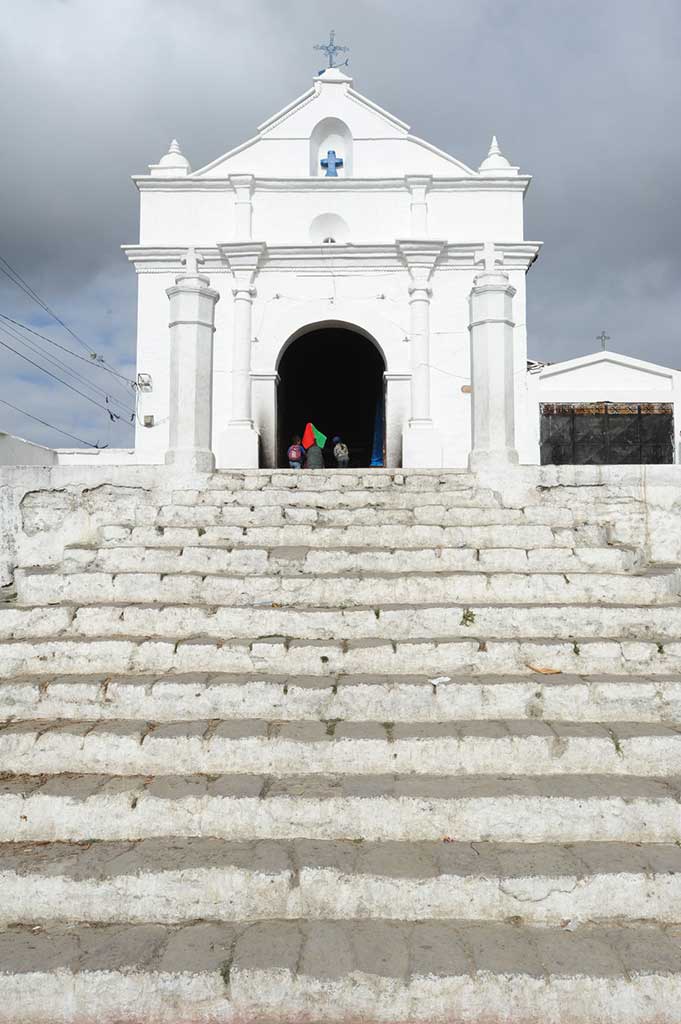At Chichi, tourism became voyeurism. There was always so much going on—the crowded, noisy market, the rituals on the steps of Santo Tomás, a ceremonial dance outside El Calvario chapel, the explosion of firecrackers in the morning, a procession—that it was easy to think it all a show put on for the tourists’ benefit. But in Chichi it was not a show. The “spectacle” was part of daily life for the Indians, ritual that must be performed in spite of, not because of, the tourists.
—Stephen Connely Benz, Guatemalan Journey
Chichicastenango (Chichi, for short) will provide you with an opportunity to take in a unique highland market experience. There are certainly other, more authentic markets in highland Guatemala, at least one of which is larger, but Chichi’s popular Sunday and Thursday market is unique in that it includes allowances for the very strong foreign presence here. It is the only highland market where you’ll see large tour buses packed with camera-toting tourists negotiating the hairpin, dizzying mountain switchbacks along the road from Antigua and Guatemala City. The road to Chichi diverts from the Pan-American Highway at the Los Encuentros Junction, along Km. 127.5.

Chichicastenango’s market offers an opportunity for people watching. Photo © Al Argueta.
You’ll find a dizzying array of good-quality weavings, pottery, fabrics, gourds, and masks, to name just a few.The market, and Chichi’s status as a bona fide tourist attraction, got their start in the 1930s when enterprising Alfred S. Clark opened the Mayan Inn and started busing folks in from the capital for a look at an authentic highland Mayan village. Chichicastenango, originally known as Chaviar, was an important Kaqchikel trading town long before the arrival of the Spanish. The Kaqchikel went to war with their K’iche’ rivals based in K’umarcaaj (near present-day Santa Cruz del Quiché, 20 miles north) in the 15th century, moving their capital to the more easily defended site of Iximché. Spanish conquistador Pedro de Alvarado would play the K’iche’-Kaqchikel rivalry to his advantage, using the latter as allies in his final push against the K’iche’, who comprised the only real opposition to Spanish conquest. Chichicastenango got its name, meaning “place of the nettles,” from Alvarado’s Nahuatl-speaking Mexican allies after the town’s reestablishment here after the defeat of the K’iche’ capital in 1524.Today, Chichi is still very much a K’iche’ town with strong adherence to the old ways. Its traditional fiesta, the Fiesta de Santo Tomás, takes place December 14-21. There are plenty of loud fireworks, traditional dances, moonshine, and the fascinating palo volador ritual in which men spin from ropes attached to a 20-meter pole.
If you’re a big fan of outdoor markets, you’ll certainly enjoy this one. In addition to the crowds of vendors and potential buyers, you’ll find a dizzying array of good-quality weavings, pottery, fabrics, gourds, and masks, to name just a few. On the stairs of the adjacent church of Santo Tomás, you’ll see Mayans waving incense burners, filling the air with the pungent smell of corozo palm and adding an additional aura of mystique to this chaotic market that is a feast for the senses. There are certainly more authentic indigenous highland markets, but what makes Chichi unique is its accommodation of visitors’ needs and desires for traditional handicrafts into a twice-weekly event (Sunday and Thursday) that would otherwise continue undeterred for the benefit of the locals it has always catered to.

Flowers on display in the Chichicastenango market at the steps of Santo Tomás. Photo © Al Argueta.
Most of the better handicrafts are found in the central part of the plaza, but be prepared to rummage through piles of lesser-quality stuff, which is readily in abundance. In addition to the main part of the plaza, there are stalls peddling tourist-oriented trinkets along the streets to the north of it. The streets to the south and the centro comercial on the plaza’s north side are home to the everyday items villagers come to market for, including fruits and vegetables, clothing, spices, household items, and baked goods.
As in all of Guatemala’s markets, haggling is in order. The best time to get a good deal on anything that might have caught your fancy is after 3pm, when the market starts to wind down. You can often score substantial price reductions simply by walking away and feigning disinterest. It’s all a very complex game. For fair trade goods, visit En Mi Salsa (5a Avenida 5-24 Zona 1, local 21, 1pm-5pm Wed., 9am-5pm Thurs./Sun., 10am-5pm Sat.) where you’ll find export-quality handmade goods.
The town’s oft-photographed church dates to 1540 and is the site of syncretic Catholic-Mayan rituals both inside and out. On the steps, you’ll find chuchkajaues—indigenous people at prayer, swinging incense-laden censers (usually just metal cans punctured with holes) and reciting incantations. Take care to enter the church through the side door to the right, as the main entrance is reserved for religious officials and chuchkajaues. Inside you’ll find an astounding number of lit candles lining the church floor along with pine boughs and offerings of liquor bottles wrapped in corn husks, flowers, and maize kernels in remembrance of departed relatives, some of whom are buried beneath the church floor. Photography is strictly prohibited inside the church.
Found beside the church is a monastery, where the Popol Vuh Mayan book was found among church archives by Spanish priest Francisco Ximénez in the early 18th century.
On the west side of the plaza is Capilla del Calvario, another whitewashed church somewhat like a miniature version of Santo Tomás and with much the same feel. There is a glass-encased Christ statue inside, which is paraded through town during Holy Week processions.

Capilla del Calvario. Photo © Stefan Ember/123rf.
The small Museo Rossbach (5a Avenida 4-47 Zona 1, 8am-noon and 2pm-5pm Tues., Wed., Fri., Sat., 8am-4pm Thurs., 8am-2pm Sun., $0.75) harbors a collection of jade objects, including necklaces and figurines in addition to historical objects such as ceremonial masks, obsidian spearheads, and incense burners. It’s named after Hugo Rossbach, a German who served as the town’s Catholic priest for many years until his death in 1944.
On a hill just outside of town is this Mayan shrine dedicated to the earth god Huyup Tak’ah (Mountain Plain) where worshippers gather frequently to perform ceremonies. The idol is a blackened pre-Columbian sculpture standing about a meter tall and lined with stones, candles, and sacrificial offerings of booze. It has been around for centuries.
Ceremonies performed by a Mayan shaman usually involve much incense, liquor-drinking, chanting, and offerings of candles, flowers, and maybe even a sacrificial chicken. If you happen to stumble upon one of these ceremonies during your visit, be sure to keep your distance and refrain from taking photographs. You can always ask for permission, but don’t be surprised if the answer is a firm “no.” To get to the shrine, walk down 5a Avenida from the main plaza turning right onto 9a Calle. At the bottom of the hill found along this street, head left onto a path through the signposted morerías (mask workshops) found there. The path continues uphill from there to the hilltop site. It’s best to go in a group and earlier in the day, as robberies of tourists along this route are not infrequent.
Excerpted from the Fifth Edition of Moon Guatemala.